Flyfishing for Suckers - by Corey Geving
2/2005
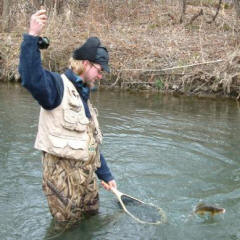 The
white sucker is one of the most common, yet underutilized fishes
in North America. Many dyed-in-the-wool trouters have landed
their ďfish of a lifetimeĒ only to find they have caught an
average-sized sucker instead of that huge trout they were
dreaming about. The look on their face is often a study of
disappointment. But why should you be disappointed after
catching a sucker? After all, you just caught a big,
hard-fighting fish. In this day and age, many anglers release
most of the fish they catch anyway, so the food value isnít a
reason for disdain (but even if it is, they just lack a good
recipe). In days gone by, suckers were blamed for declining
trout and bass populations, but recent studies show that suckers
actually enhance predator populations by providing a source of
meaty forage. So why not try your hand at catching a few of
these abundant fish? And why not be proud of it, too? The
white sucker is one of the most common, yet underutilized fishes
in North America. Many dyed-in-the-wool trouters have landed
their ďfish of a lifetimeĒ only to find they have caught an
average-sized sucker instead of that huge trout they were
dreaming about. The look on their face is often a study of
disappointment. But why should you be disappointed after
catching a sucker? After all, you just caught a big,
hard-fighting fish. In this day and age, many anglers release
most of the fish they catch anyway, so the food value isnít a
reason for disdain (but even if it is, they just lack a good
recipe). In days gone by, suckers were blamed for declining
trout and bass populations, but recent studies show that suckers
actually enhance predator populations by providing a source of
meaty forage. So why not try your hand at catching a few of
these abundant fish? And why not be proud of it, too?
|
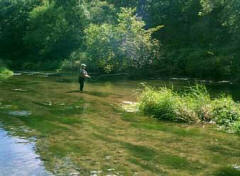
It has been said that the best way
to find a place to fish for suckers is to look for a blue
squiggly line on a map, then drive there and start fishing. Itís
not always that simple, of course, but this hardy fish is found
throughout north America, even in places where few other fish
live. From large, windswept lakes, to tiny drainage ditches in
the middle of suburbia, white suckers always find a home. In
fact, there is probably some great sucker water very near where
you live. |
 White
suckers eat mostly insect larvae, just like trout do, so a wide
variety of trout flies will work very well for suckers. But
while the trout will almost always key in on insects either on
or in the surface film, or drifting freely in the current,
suckers concentrate on insects that are on, or very close to,
the bottom. Tiny clams, crustaceans, and worms are also prime
sucker fare. Invariably, these morsels are snatched from on or
near the bottom. Weighted versions of the Gold-Ribbed Hareís
Ear, the Pheasant Tail, Scud patterns, San Juan Worms, and
caddis Pupae are all good choices for pursuing suckers. Nymphs
sized from 16 to 12 are perfect for suckers, but sometimes
slightly bigger or smaller flies may take more fish. White
suckers eat mostly insect larvae, just like trout do, so a wide
variety of trout flies will work very well for suckers. But
while the trout will almost always key in on insects either on
or in the surface film, or drifting freely in the current,
suckers concentrate on insects that are on, or very close to,
the bottom. Tiny clams, crustaceans, and worms are also prime
sucker fare. Invariably, these morsels are snatched from on or
near the bottom. Weighted versions of the Gold-Ribbed Hareís
Ear, the Pheasant Tail, Scud patterns, San Juan Worms, and
caddis Pupae are all good choices for pursuing suckers. Nymphs
sized from 16 to 12 are perfect for suckers, but sometimes
slightly bigger or smaller flies may take more fish.
|
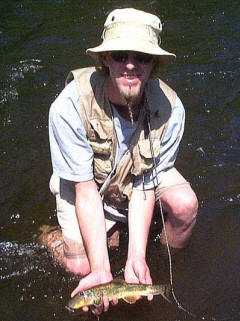
Suckers utilize many different
portions of a stream. They may feed heavily in productive
riffles, but itís difficult to catch them there. Riffles are the
most productive areas of the stream. Thatís why a lot of the
most spectacular fly hatches occur in or near riffles. Trout
like to snatch drifting nymphs in riffles, but suckers do not.
Why? Well, my theory is that the sucker, unlike the trout,
doesnít have to wait for food to drift in itís direction.
Suckers have the ability to feed in and among the rocks and
snags on the bottom of the riffle, scraping stationary food
right off the surface of the rocks. Trout canít feed on these
firmly attached clinging nymphs until they decide to hatch.
Suckers will even wedge their heads under or between rocks to
get at critters hiding in the crevices. For a sucker, a drifting
nymph in fast water is not worth the effort it takes to chase it
down. |
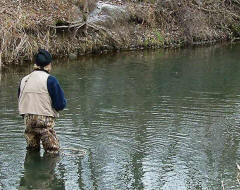
Suckers in slow water are much
more vulnerable to flies. Here, insect life is scarce, and food
critters drifting just above the bottom are easy for suckers to
catch. All they must do is turn their heads and inhale the free
food. Fortunately, itís fairly common to find a pod of large
suckers fining in a slow-flowing pool or deep run. So letís say
youíve found yourself a fine pod of large suckers in a nice,
slow section of water, or a good pool that looks like it should
hold some. Whatís next? |
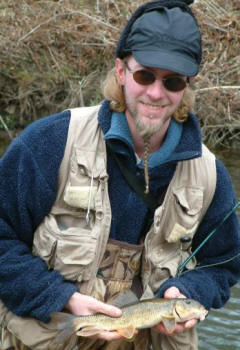
In my opinion, any rig that gets
the fly down to the fish and moves it along drag-free will work.
For many people, this is a shot-and-indicator rig. Others forego
the indicator and fish by feel. Both methods will work, as long
as the fly is traveling right along the bottom at the same speed
as the current. My favorite tactic is to fish an indicator rig
directly upstream or slightly across, allowing the offering to
drift down through the school of suckers.
|
 The
take of a white sucker is very subtle. If using an indicator,
watch it closely. The indicator will either pause or dip for a
fraction of a second before the fish spits out the fly. Suckers
have an amazing sense of taste and will reject a fake insect
almost instantly. If not using an indicator, youíll need to
develop a sixth sense to detect strikes. Wait for a slight
hesitation in drift, a slight increase or decrease in tension,
or a small tap on the line. In either case, you must strike
quickly, but softly, to avoid breaking your tippet. The average
sucker weighs several pounds, so be ready for battle! The fight
of a sucker is usually a series of strong, determined runs, but
occasionally they will surprise you by jumping and even
tailwalking when hooked. Have a net handy to help get the fish
under control. The rubbery lips of the sucker hold hooks well,
so be sure to bring a forceps along to disgorge hooks. Barbless
hooks are easier to remove. Suckers are quite hardy when hooked
on flies, so feel free to snap a photo or two of your catch. The
take of a white sucker is very subtle. If using an indicator,
watch it closely. The indicator will either pause or dip for a
fraction of a second before the fish spits out the fly. Suckers
have an amazing sense of taste and will reject a fake insect
almost instantly. If not using an indicator, youíll need to
develop a sixth sense to detect strikes. Wait for a slight
hesitation in drift, a slight increase or decrease in tension,
or a small tap on the line. In either case, you must strike
quickly, but softly, to avoid breaking your tippet. The average
sucker weighs several pounds, so be ready for battle! The fight
of a sucker is usually a series of strong, determined runs, but
occasionally they will surprise you by jumping and even
tailwalking when hooked. Have a net handy to help get the fish
under control. The rubbery lips of the sucker hold hooks well,
so be sure to bring a forceps along to disgorge hooks. Barbless
hooks are easier to remove. Suckers are quite hardy when hooked
on flies, so feel free to snap a photo or two of your catch.
|
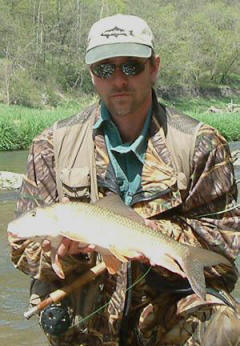
Of course, the white sucker is
only one of the many species of sucker. Over 50 species of
suckers are native to north America, ranging from the tiny,
half-pound hog sucker to 90 pound buffalos and sporty, 15 pound
clam-eating river redhorse. Each species requires different
tactics, flies, and locations. Some are almost completely
unknown in the flyfishing world. Flyrod records for many of
these fish donít even exist.
Now where did I put that box of
clam fliesÖ?
|
|
Previous Page
The Buckeye United Fly Fishers, Inc is a non-profit corporation organized under section 501(c)(3) of the Internal Revenue Code, incorporated in the State of Ohio for the preservation, conservation and wise use of our fishing waters and game fish; and to assist in the protection and improvement of our natural resources
|
|